Intel Details Manufacturing through 2023: 7nm, 7+, 7++, with Next Gen Packaging
by Ian Cutress & Anton Shilov on May 8, 2019 4:35 PM ESTAt Intel's Investor Day today, CEO Bob Swan and Murthy Renduchintala spoke to the ability of the company with respect to its manufacturing capabilities. Intel has historically been strong in its ability to execute on its process technology, however the delay of its 10nm process has obviously raised multiple question marks, and has done for several years. The two Intel executives went into a little detail about what Intel was doing in the interim, and how it has learned from the issues.
Back in 2013, Intel envisoned its 10nm to succeed the 14nm by providing 2.7x density, with new technologies such as Self-Aligned Quad Patterning (SAQP), Contact over Active Gate (COAG), Cobolt Interconnects, and new packaging technologies such as EMIB and Foveros. Intel admits that this was an ambitious plan, and the goals were not clearly defined with the teams and it was ultimately overly complex and not managed in an ideal way.
This ended up pushing 10nm out into a later time frame. In this case, Intel pushed 10nm out to 2019 (technically they shipped Cannon Lake in small quantities on 10nm in 2017, however that is nothing more than a curio in the timeline of semiconductors), and filled the gap with 14+ and 14++.
Intels 14+ and 14++ processes extracted more than 20% more performance (from Broadwell to Whiskey Lake) from the process since its inception. As a result, Intel is prepared to not only get ready for future intra-node optimizations, but actually adjust the roadmap to compensate for it. Murthy made it clear that Intel wants to introduce a Moore's Law-like gain at the beginning of a new process, and another similar gain by the end of the process.
Intel has stated that its 10nm product family (beyond Cannon Lake) will start to be available from the middle of this year (2019), with Ice Lake on client platforms (notebooks).
Intel will be launching multiple 10nm products through 2019 and 2020, including server based 10nm in the first half of 2020:
In the above slide, Intel states that it will have 7nm in production and launching a product in 2021. That sounds very aggressive for a company that has had issues with 10nm. It even shows in Intels radmap, with 10nm (and 10+ and 10++) having a much shorter life cycle than the 14nm family of processes.
With this in mind, Intel's 7nm is going to be the combination of what Intel has learned from the 14nm and 10nm family of products. Intel wants that 2x scaling (Moores Law), but with intra-node optimations planned as part of the roadmap. Intel is also reducing its number of design rules, which should help with execution. 7nm will also be where Intel intersects with EUV, and also introduce next-gen Foveros and EMIB packainging.
Intel provided this slide, which shows a monolithic PC-Centric die with a multi-die Data-Centric chip built on both Foveros and EMIB. This corroborates our discussion with Intel's chiplet and packaging team, who also stated that we would see Foveros and EMIB on a combined product - specifically the GPU.
Intel announced that its lead 7nm product (lead = top, or lead = first?) would be its new GPGPU, built on the Xe graphics architecture. Intel has stated that its Xe product stack will feature two different microarchitectures from mobile client up to GPGPU, with one of those architectures called Arctic Sound - technically Intel will launch its first discrete GPU in 2020 according to its press release, however the 7nm GPGPU will be launched in 2021.
More information is coming out of Intel's Event, more to follow.
Related Reading
- Intel: EUV-Enabled 7nm Process Tech is on Track
- Intel Starts Qualification of Ice Lake CPUs, Raises 10nm Volume Expectation for 2019
- Intel Agilex: 10nm FPGAs with PCIe 5.0, DDR5, and CXL
- Intel to Equip Fab 42 for 7 nm
- Intel Discloses Plans to Spend $5 Billion on Fab 28 Expansion in Israel
- Intel Submits Ireland Fab Expansion Plan: $8 Billion Price Tag, With a 4 Year Lead Time
- Intel Details Plans for Its Oregon Fab Expansion: D1X Phase 3
- Intel to Expand Production Capacities at Multiple Fabs
Source: Intel


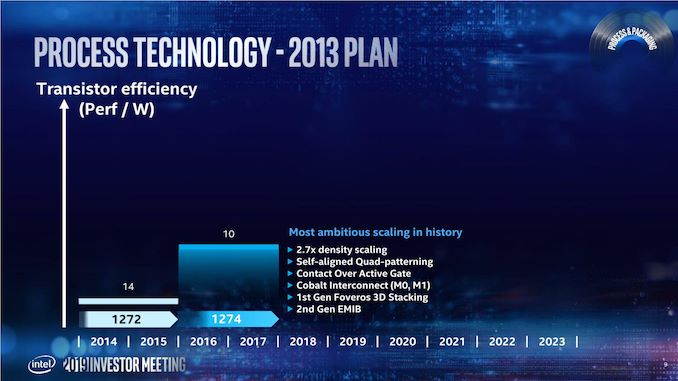

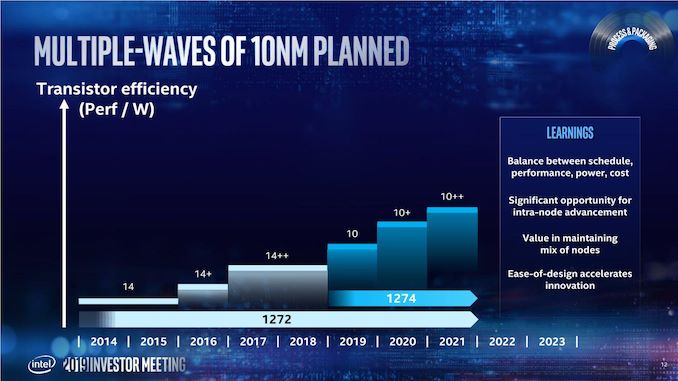
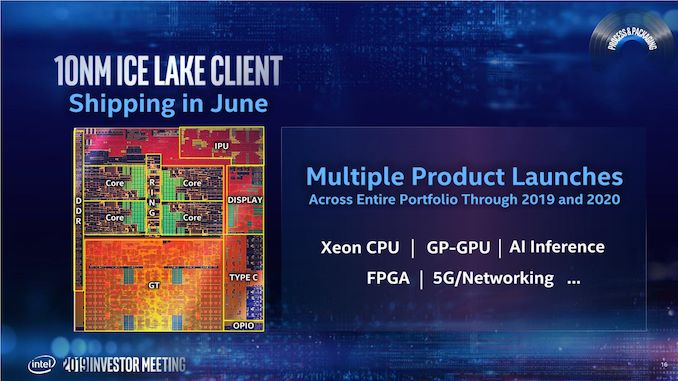
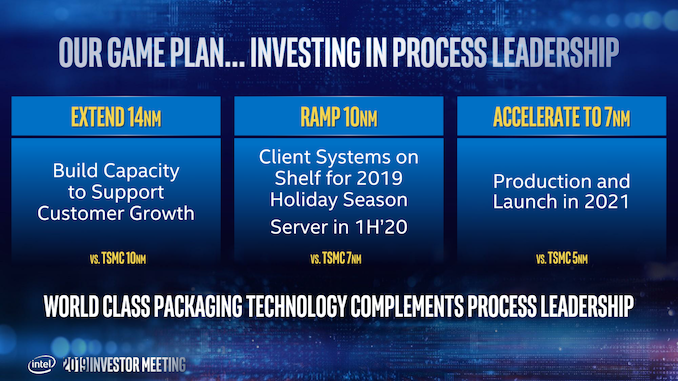
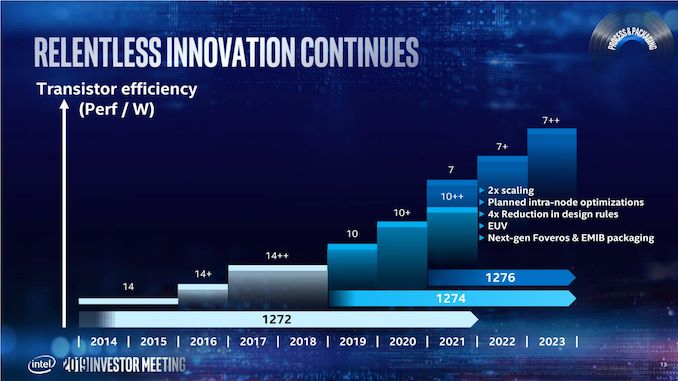

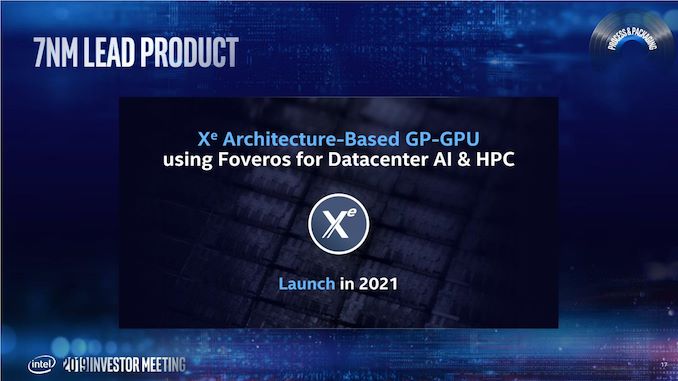








237 Comments
View All Comments
Korguz - Thursday, May 9, 2019 - link
so says the intel fanboy.... defending his beloved intel... " but an entirely new architexture called Sunny Cove" to bad sunny cove.. is NOT an " entirely new architecture * again.. the X SHOULD BE A C ) its just an up date to the SAME architecture intel has been using for the last 10 or 15 years now... just HStewart is to much of a fanboy to see it. " Intel is not stupid and they are not sitting around " ahh but they HAVE been... and have now.. just gotten up off their butt, and are playing catch up...Opencg - Thursday, May 9, 2019 - link
i mean no, they are not sitting around at all. they were in relative stagnation for a while. but intel is famous for throwing money all over the place. and having a blunder make them look really bad here and there, only to come back even stronger when another plan comes to fruition.as for the end of your comment well it appears you are so stupid that even the most basic of understandings of architecture evades you. in this case you are too dumb for me to even reason with so ill just let you be. have a nice day
Korguz - Thursday, May 9, 2019 - link
not sitting around at all ?? really ?? how long were we stuck at quad core on the mainstream desktop ?? they " could " of added more cores.. but they didnt.. until zen came out.. then all of a sudden.. mainstream desktop from intel came out with more cores... " relative stagnation " only cause they had NO reason to innovate or do anything more then give is 10% preformance increases year over year... opencg sure if you say so... sound like you are a bit of an intel fanboy your self... sunny cove is still based on the same architecture as the previous cpus.. just updated... but please.. post a link that says other wise, so i can read it as well...Opencg - Thursday, May 9, 2019 - link
im hardly an intel fanboy. right now i have my money on amd. this is mostly to do with multi chip architectures and how they can overcome the dwindling performance / price gain we are destined to see from process nodes. amd used a limited r/d budget to form an interconnected approach that targets multiple product types and takes into account fabrication stagnation. infinity fabric is used to make zen into super high core count versions while the single die zen processors hit multiple sub markets at once. navi also uses infinity fabric.dont get me wrong the comming 2019 products are very exciting. but the most exciting thing to me is the continued advancement of performance / price to consumers in the face of the end of moore's law via single chip fabrication techniques. and amd has shown that it started preparing for this at tbe most ideal time. a smart company indeed.
but i dont fanboy out. just like with nvidia having a great 900 and 1000 series architecture followed by a bad joke of a 2000 series, my favoritism ends with bad calls by any company
Targon - Friday, May 10, 2019 - link
Navi won't use Infinity Fabric, I don't know where people are getting that idea. AMD did look forward when it came to the design for Zen, and for the new GPU architecture that will follow, while Intel is still limited by tunnel vision.HStewart - Thursday, May 9, 2019 - link
I personally have no relationship to Intel, actually you would think that I would not like them, in early 90's I was invited to Intel for development and at the time they did not need Assembly Language developer and they want at the time C++ which I very proficient now - I did meet one of designed of P 5 *Pentium) and I mention if they could Virtualize the 386 and at that time they could not but they can now. I personally did not like area. I was writing a DPMI driver for OS at the time. It never happen but just because I prefer and respect Intel products does not call me a fanboy - just to let you know I have 30 years in computers and not just a kid playing gamesOne thing for sure is that Sunny Cove is just as much as new architexture as AMD's Zen is compare to older versions of AMD CPU's. Sunny Cove is not Skylake version 2 but please look at diagrams - new units and cache units are part of it designed.
It will be soon time for AMD to play catchup - Sunny Cove is going kick AMD off the map. I expect that and time will show it will do so.
Korguz - Thursday, May 9, 2019 - link
" respect Intel products does not call me a fanboy " oh really?? then WHY do you ALWAYS praise intel, no matter what, but yet.. bash AMD ?? that is what a fan boy does.. you see intel as the god of the cpu, and amd as nothing.. how is sunny cove a new architecture ( notice the C ?? ) FYI.. zen, compared to AMDs prev architecture ( bulldozer ), is very different, so it is new.. while sunny cove.. as you have stated.. new units and cache units are part of its design, but not a complete redesign as Zen is over BulldozerSunny Cove is going kick AMD off the map. yea sure.. and you know this how ???
HStewart - Thursday, May 9, 2019 - link
It just a feeling about Sunny Cove, a technical hunch and right now that all we have to go by - it because of technical changes in architexture, yes it possible the deigned could mess up and have issues - but Intel has spent a lot on this and I believe by it designed it going be quite a performer. But important part is like everything else on the net it is a only a personal opinion. You have yours and I have mind - so live with it - time will tell.If you want to know that Sunny Cove is new architexture, look at the designed chats from the article provided earlier by AnandTech. To me updating cache is not a big deal - but increase the units from 8 to 10 and other changes in it so it handles more instruction per clock cycle is architexture change. Sunny Cove is vastly improved over Sky Lake.
I don't know much or even care much about AMD stuff - only that from what I know from results is that Intel has per core faster performance than AMD and Intel indicates that Sunny Core single core performance. Also AMD answer to issues is just add more core, while Intel is improving the core design, It sounds like from AMD fans that Zen is better than Bulldozer but how much on single core, I have no idea.
Korguz - Thursday, May 9, 2019 - link
yes time will tell.. and my hunch.. it wont be as great as you seem to think it will be..." but increase the units from 8 to 10 and other changes in it so it handles more instruction per clock cycle is architexture change " that is NOT an architeCture change ( yet again.. change the X to a C Hstewart ) that is just updating/tweaking an existing architeCture..
" Also AMD answer to issues is just add more core, while Intel is improving the core design " and amd hasnt been doing the same thing with zen+ and zen 2 ??? zen IS better then bulldozer, amd went from not being able to compete with intel.. to being on par, or faster then intel depending on what was being run on the cpus....
FYI.... you should care more about amd stuff.. if it wasnt for zen, we would STILL be stuck with quad core on the mainstream, and probably paying even MORE for intels cpus then we are now...
rrinker - Friday, May 10, 2019 - link
But for what purpose? What, pray tell, MAINSTREAM use case really needs more than 4 cores? Enthusiast gaming is not mainstream. Massive parallel machine learning is not mainstream. Mainstream is Joe and Jane Smith browsing Facebook and sharing cat pictures at home, and working on some spreadsheets and word documents at work. In terms of performance, a computer from 5 years ago is more than adequate for that. MY work laptop has an I7, 2 core with hyperthreading. I regularly run multiple VMs plus the base system (it does have 32GB RAM at least) with no issues. So tell me again how I need 16 or 32 cores in a machine at this level?Even my newest machine at home, now 2 years old, I went with an I5 instead of I7, and didn't even install a discrete GPU of any sort. It's my hobby workbench computer. The I5 using Intel's not so awesome graphics handles EDA for my circuit design with no problem. It handles the 3D CAD program I use for designing model railroads just fine as well. I have several programming IDEs installed on it. I have electronic tools such as a USB based logic analyzer, that stuff all works fine. In fact, it probably would have been fine with an I3. I'd consider these sorts of applications outside of mainstream use, yet they all run perfectly fine with 4 cores. I haven't had to wait for any computer to catch up to me for years now. As in, the bottleneck in response time has not been the machine itself, always something external - internet speed, network speed, slow site.
Hey, it's great marketing, why settle for 4 when you can have 16, but for MAINSTREAM use it doesn't really buy you anything other than bragging rights.
For use cases where the huge core count actually DOES help - that's a completely different argument. Though it seems this is lost on many people. Maybe because everyone reading all the enthusiast web sites starts to think what they do IS mainstream. It's not. For every killer gaming rig that can outcompute NASA from 5 years ago, there are probably 1000 or more machines sitting in office cubicles that would probably be just as effective for the end user if they had cheap Celerons in them. THAT'S the mainstream.